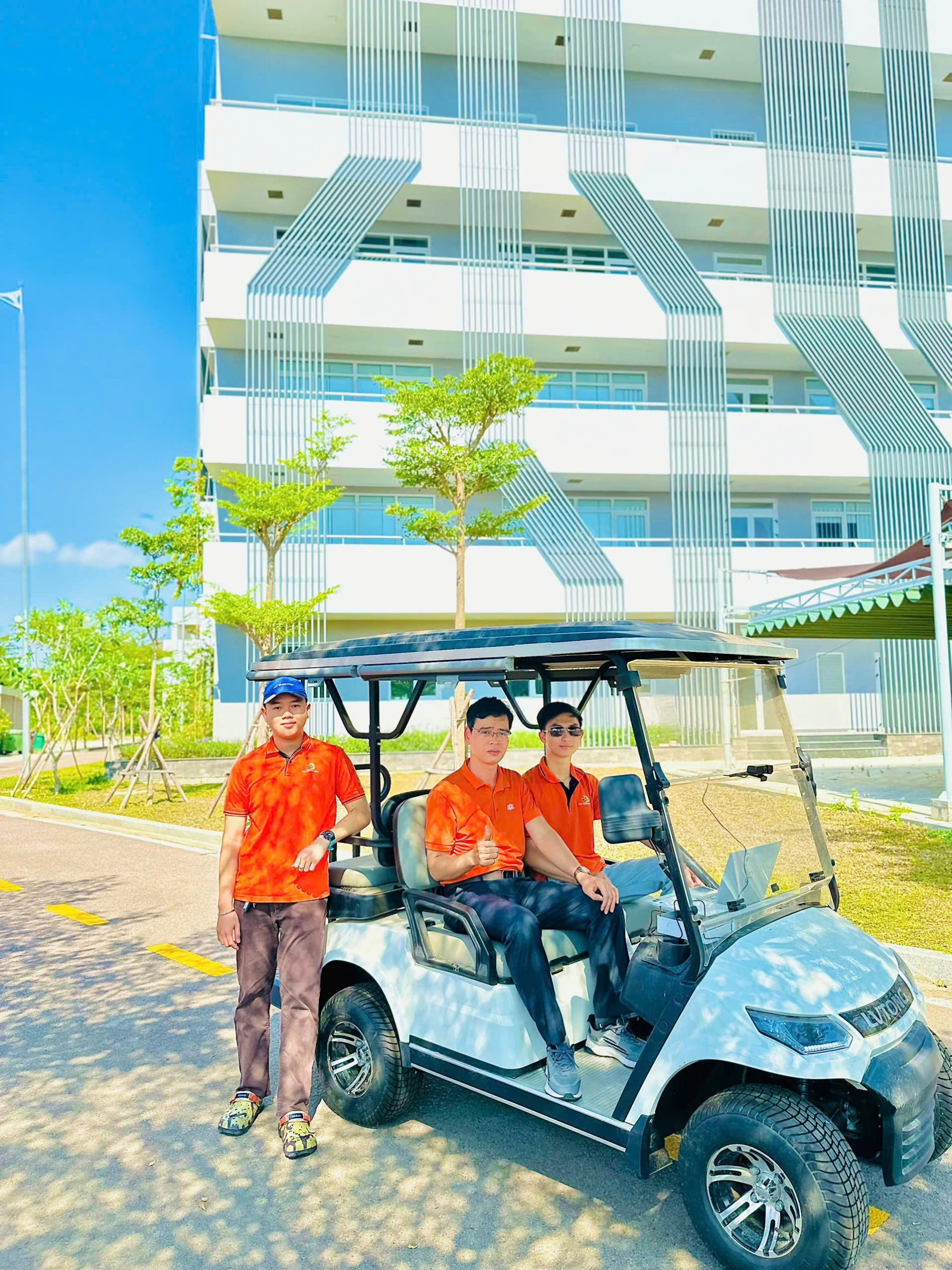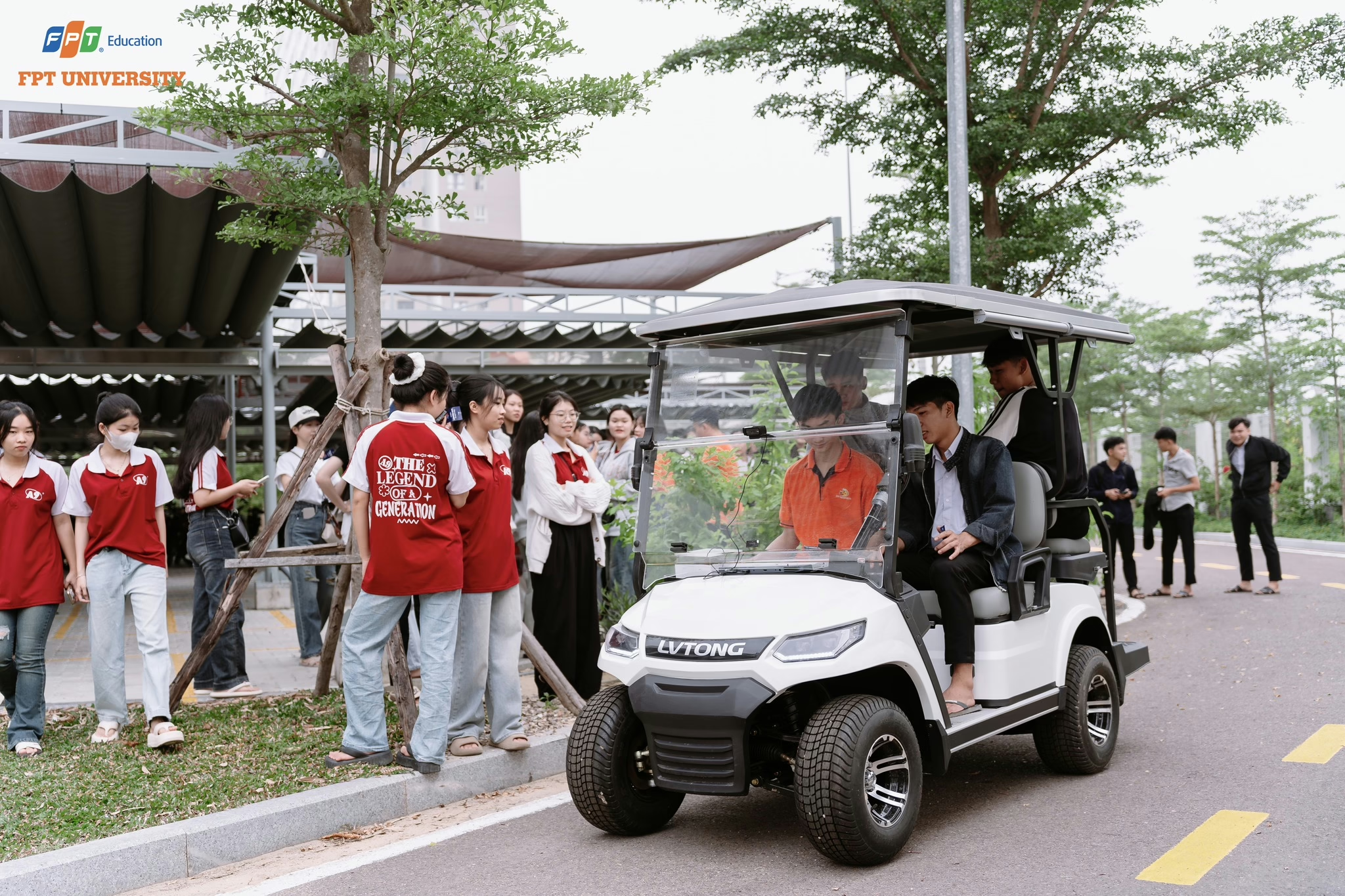The self-driving campus tour vehicle initiative not only enhances the on-campus visitor experience but also affirms FPT University’s pioneering role in AI education and real-world application.
The autonomous vehicle project at FPT University’s Quy Nhon campus is the result of collaboration between faculty members — Nguyen Van Vinh, Head of the Software Engineering Department, and lecturer Nguyen Quang Duy — and students Ho Ton Bao, Ha Khai Hoan (K18, Artificial Intelligence), and Tran Xuan Hien (K19, Software Engineering).
According to Nguyen Van Vinh, the original idea was inspired by a desire to provide students with hands-on experience in the field of Artificial Intelligence (AI). The team selected a standard four-seater golf cart, originally lacking any smart systems or safety features, as the development base. From there, the group installed sensors, control devices, and programmed AI functions to transform the cart into a smart, safe, and convenient transport solution for campus tours.
Integrating Advanced Technologies into a Smart, Functional Prototype
Design and technology selection were crucial in the early stages. The vehicle was equipped with state-of-the-art sensors including LIDAR, cameras, GPS, and a powerful central control module. These were supported by AI algorithms, computer vision, and autonomous navigation systems — all powered by the NVIDIA Jetson Xavier development kit.

In the hardware and software integration phase, students Bao, Hoan, and Hien worked across both fronts. They designed the control system, developed image processing algorithms for obstacle detection, and programmed navigation features to ensure the vehicle could follow pre-defined routes accurately.
During testing and optimization, the team deployed the vehicle on various campus paths. Data was continuously collected and analyzed to refine the algorithms, improve object detection accuracy, and enhance the vehicle’s overall stability and performance.
According to Mr. Vinh, a key feature of the project lies in its comprehensive use of AI to ensure safe and accurate vehicle operation in the campus’s open environment.
Specifically, the system integrates multiple modern technologies, enabling the vehicle to recognize pedestrians, vehicles, signage, and obstacles via computer vision and deep learning. The real-time localization and mapping system remains functional even when GPS signals are lost, thanks to LIDAR and SLAM algorithms.
Sensor fusion — combining GPS, LIDAR, camera, and inertial measurement data — increases environmental awareness and location accuracy. The vehicle can autonomously select optimal routes and avoid obstacles using path-planning algorithms. Reinforcement Learning has also been implemented to enhance the vehicle’s adaptive control abilities, such as adjusting speed in pedestrian-heavy areas.
Overcoming Technical Challenges to Transform a Basic Golf Cart into an Autonomous Vehicle

The transformation process posed multiple challenges. As the base cart only supported manual operation, the team had to study its mechanical system and integrate actuators to control the steering, throttle, and brakes electronically.
The limited physical space required careful placement of components like LIDAR, 360-degree cameras, and GPS receivers to ensure clear visibility, aesthetics, and safety. Increased power consumption from added electronics also led to battery upgrades and the creation of a power management system to support long-term operation.
Because the vehicle lacked a modern CAN bus communication system like traditional cars, a custom middleware was developed to coordinate communication between control units, sensors, and the central processor. Multiple rounds of testing and fine-tuning were conducted to ensure safe operation in real-world conditions, including turning, climbing mild slopes, and responding to pedestrian movements.
Deployed During University Events, With Plans for Expansion
After three months of development, the self-driving vehicle officially debuted during FPT Unixperience events in March and April, transporting visitors around campus. The team is now working on new features such as a mobile app for scheduling rides, an AI-powered audio tour guide, and an emergency stop system to ensure maximum safety.
Beyond its technological novelty, the autonomous tour vehicle offers FPT University students rich hands-on learning opportunities. Alongside theoretical knowledge in computer vision, signal processing, and deep learning, students actively participated in building, testing, and refining a complete AI system. The project also fostered systems thinking and interdisciplinary teamwork — key skills for careers in AI and robotics.
“With the initial success of the self-driving campus tour vehicle, the university is planning to expand into other real-world AI applications. Some concepts under development include campus guide robots, smart parking systems using computer vision, and AI-based safety and environment monitoring solutions,” said Mr. Vinh.
Additionally, the project team is preparing to implement the autonomous vehicle model at other FPT University campuses. Through these initiatives, FPT University aims to build a comprehensive ecosystem for AI learning, research, and application — one that is deeply rooted in real-world needs and aligned with global technology trends.



